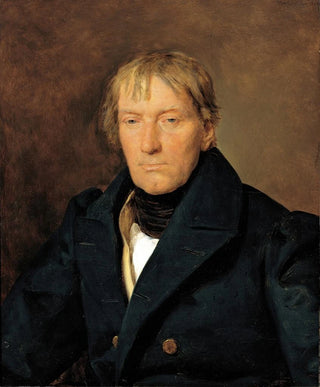Art print | The engraver François Haury - Ferdinand Georg Waldmüller


View from behind

Frame (optional)
In the vast panorama of art history, some works stand out for their ability to capture the essence of their era while revealing nuances of their creator's personality. The art print Le graveur François Haury - Ferdinand Georg Waldmüller is a striking example. This piece, highlighting the talent of engraver François Haury, marks a pivotal moment in 19th-century Austrian art. Waldmüller, with his mastery of portraiture, invites viewers to immerse themselves in a universe of delicacy and psychological depth. Through this creation, the viewer is transported into a visual dialogue between the artist and his model, revealing subtle emotions and details that sketch a much broader story.
Style and uniqueness of the work
Ferdinand Georg Waldmüller's work is characterized by a realistic and intimate approach, where every detail is carefully considered to reflect the personality of the subject. In the art print Le graveur François Haury, the artist manages to transcend mere physical representation to capture the soul of the engraver. The play of light and shadow, along with the finesse of the features, testify to a refined technique that places Waldmüller among the great masters of his time. His style, which combines precision and sensitivity, allows for a rare emotional depth. This piece thus becomes a mirror, not only of Haury's talent but also of the era in which they evolved, marked by artistic and social upheavals. Waldmüller succeeds in immortalizing a moment, creating a timeless link between the viewer and the subject.
The artist and his influence
Ferdinand Georg Waldmüller, born in 1793 in Vienna, is an emblematic figure of the realist movement in Austria. His artistic journey is marked by encounters and influences that led him to develop a unique style, blending meticulous observation with human sensitivity. Beyond his painting technique, Waldmüller also had a significant impact on his contemporaries and subsequent generations. His approach to portraiture, which prioritizes authenticity and the psychology of characters, has opened

Matte finish

View from behind

Frame (optional)
In the vast panorama of art history, some works stand out for their ability to capture the essence of their era while revealing nuances of their creator's personality. The art print Le graveur François Haury - Ferdinand Georg Waldmüller is a striking example. This piece, highlighting the talent of engraver François Haury, marks a pivotal moment in 19th-century Austrian art. Waldmüller, with his mastery of portraiture, invites viewers to immerse themselves in a universe of delicacy and psychological depth. Through this creation, the viewer is transported into a visual dialogue between the artist and his model, revealing subtle emotions and details that sketch a much broader story.
Style and uniqueness of the work
Ferdinand Georg Waldmüller's work is characterized by a realistic and intimate approach, where every detail is carefully considered to reflect the personality of the subject. In the art print Le graveur François Haury, the artist manages to transcend mere physical representation to capture the soul of the engraver. The play of light and shadow, along with the finesse of the features, testify to a refined technique that places Waldmüller among the great masters of his time. His style, which combines precision and sensitivity, allows for a rare emotional depth. This piece thus becomes a mirror, not only of Haury's talent but also of the era in which they evolved, marked by artistic and social upheavals. Waldmüller succeeds in immortalizing a moment, creating a timeless link between the viewer and the subject.
The artist and his influence
Ferdinand Georg Waldmüller, born in 1793 in Vienna, is an emblematic figure of the realist movement in Austria. His artistic journey is marked by encounters and influences that led him to develop a unique style, blending meticulous observation with human sensitivity. Beyond his painting technique, Waldmüller also had a significant impact on his contemporaries and subsequent generations. His approach to portraiture, which prioritizes authenticity and the psychology of characters, has opened






